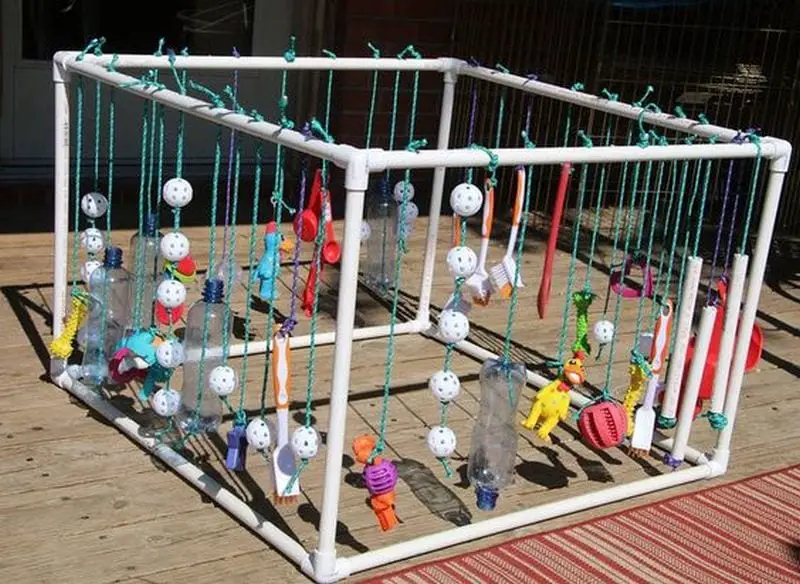
Puppy play boxes are all the rage nowadays. These boxes are excellent stimulators for puppies in the early stages of their lives.
Puppies start learning from birth. Good breeders begin handling and socialization training right away. In fact, some training can begin as soon as the puppy can open its eyes and walk!
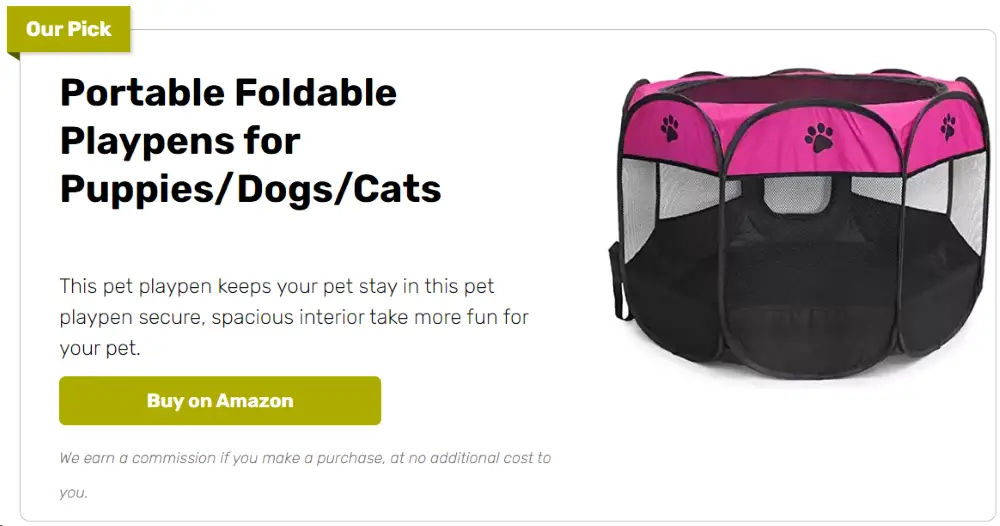
Studies show that play is key to the well-being of dogs. Puppies that don’t engage in a lot of play later suffer from behavioral issues such as anxiety and aggression, according to research.
Through this box, puppies are introduced to the different senses they’ll experience later on in life. They’ll be able to familiarize themselves with sounds, sights, motion, and touch.
If your puppy is about 5-10 weeks old, you can build your pet this DIY puppy play box. It’s an inexpensive way of stimulating normal growth and development. Make this a fun family project. Ask your kids to donate their old toys and join you in making the play box.
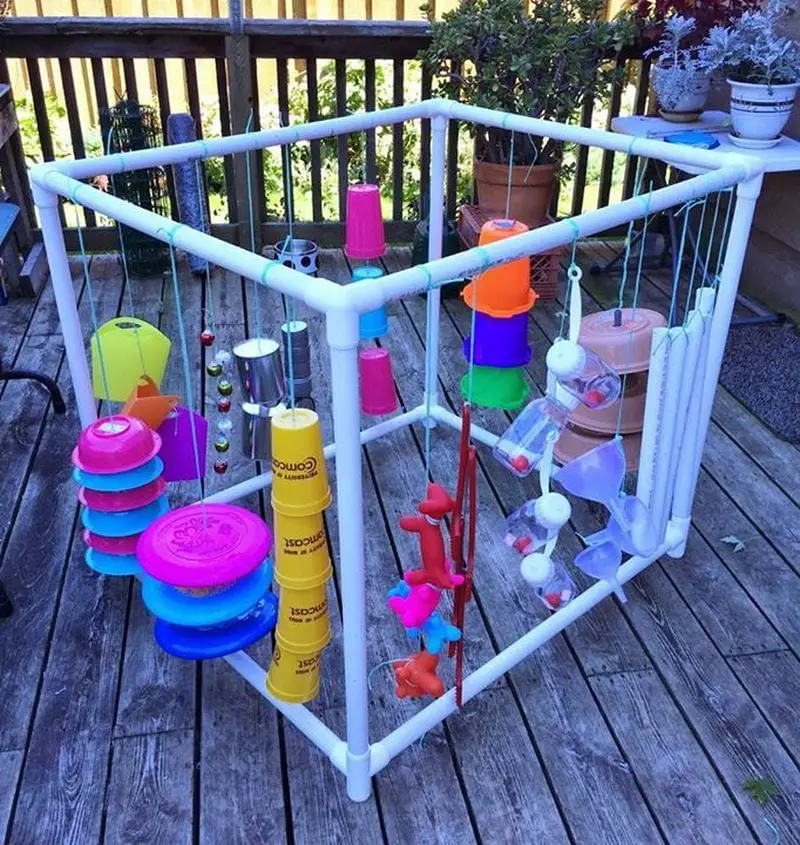
You may already have most of the materials needed to make one anyway. On the other hand, you can easily get the PVC pipe from your local store.
Contents
- 1 Building a Puppy Play Box
- 2 Benefits of a Puppy Play Box
- 3 Creative Variations for Your Puppy Play Box
- 4 Safety Tips for Your Puppy Play Box
- 5 FAQ for DIY Puppy Play Box
- 5.1 What age should my puppy start using the play box?
- 5.2 How often should I change the items in the play box?
- 5.3 Can I use recycled materials to make a puppy play box?
- 5.4 How big should the puppy play box be?
- 5.5 How can I ensure the play box is safe for my puppy?
- 5.6 Can I leave my puppy alone with the play box?
- 5.7 Are there any specific materials I should avoid using in the play box?
- 5.8 How do I clean the puppy play box?
- 5.9 Can the play box be used for training purposes?
- 5.10 What if my puppy is afraid of the play box?
- 6 Conclusion
Building a Puppy Play Box
Materials:
- 12 pcs 30″ lengths of 1″ PVC
- 8 pcs 1-in Diameter 90-Degree PVC Side Outlet Elbow
- 1⁄4″ drill bit
- Thin string or cord
- Fun things to tie on (tennis balls, cups, hose, plastic spoons, cans no edges, etc…)
Tools:
- Drill
Instructions:
Assemble the Base and Sides
- Lay out four pieces of the 30-inch PVC pipes to form a square. Connect each corner using the 90-degree PVC elbows. This will be the base of your play box.
- Attach a 30-inch PVC pipe vertically to each of the elbows. These will be the sides of your play box.
Construct the Top Frame
- Use the remaining four pieces of PVC pipe and four elbows to create a square frame. This will be the top of your play box.
- Attach this top frame to the vertical PVC pipes, completing the box frame.
Drill Holes for the Strings
- Use the 1/4-inch drill bit to drill holes randomly along the top PVC pipes. These holes will be used to attach the toys and items for stimulation.
Attach the Fun Items
- Cut varying lengths of string or cord.
- Thread the strings through the holes you’ve drilled in the top frame.
- Tie the fun items (tennis balls, cups, etc.) at the other end of the strings. Ensure they hang at different heights to provide variety for your puppy.
Secure Everything Safely
- Double-check that all items are securely attached and that there are no sharp edges or choking hazards.
- Test the sturdiness of the play box to ensure it can withstand a puppy’s play.
Benefits of a Puppy Play Box
A DIY puppy play box is more than just a fun project. It’s a vital tool for your puppy’s development. This article explores the numerous benefits of introducing a puppy play box into your pet’s life.
Enhances Sensory Development
Puppies, like young children, learn about their world primarily through their senses. A puppy play box is an excellent tool for this developmental stage. It offers a variety of experiences that stimulate sight, sound, touch, and motion.
Bright colors and different textures in the box can capture a puppy’s visual interest, enhancing their sight. Sounds from jingling bells or crinkling materials stimulate their auditory senses. Varied surfaces, from smooth plastics to soft fabrics, introduce diverse tactile experiences.
Moving parts in the box, such as swinging toys or rolling balls, help puppies understand and interact with moving objects. This broad range of sensory stimulation is critical in shaping a well-adjusted, responsive adult dog.
Promotes Physical Activity
Physical activity is vital for a puppy’s health and well-being, and a puppy play box is a fantastic way to encourage this. These play boxes are designed to entice puppies to engage in physical play. Jumping at hanging toys, pawing through different elements, and moving around to explore various parts of the box are great ways for puppies to exercise.
This kind of play helps in developing their muscle strength, coordination, and agility. Regular interaction with a play box also prevents boredom and associated destructive behaviors. It’s a fun and effective way to channel their energy positively, contributing to their physical development and overall health.
Aids in Cognitive Growth
A puppy play box is not just a source of physical activity; it’s a significant contributor to cognitive development in young dogs. The diversity of objects and challenges presented within a puppy play box provides essential mental stimulation. Puppies learn through interaction, and the varied elements of the play box encourage this exploratory behavior.
Interactive toys and puzzles within the box foster problem-solving skills. For example, toys that release treats when manipulated correctly teach puppies cause and effect.
This kind of engagement sharpens their cognitive abilities and improves their ability to learn and adapt to new situations. It also nurtures curiosity and exploratory behavior, which are vital aspects of cognitive health.
Moreover, consistent interaction with a puppy play box can enhance a puppy’s attention span and concentration. These skills are crucial for future training and obedience. The cognitive stimulation offered by the play box lays a strong foundation for a puppy’s overall mental development, ensuring they grow into intelligent and responsive adult dogs.
Incorporating a puppy play box into your pet’s routine offers numerous benefits. It’s not just a source of entertainment; it’s a crucial element in their growth and development.
Click on any image to start the lightbox display. Use your Esc key to close the lightbox.





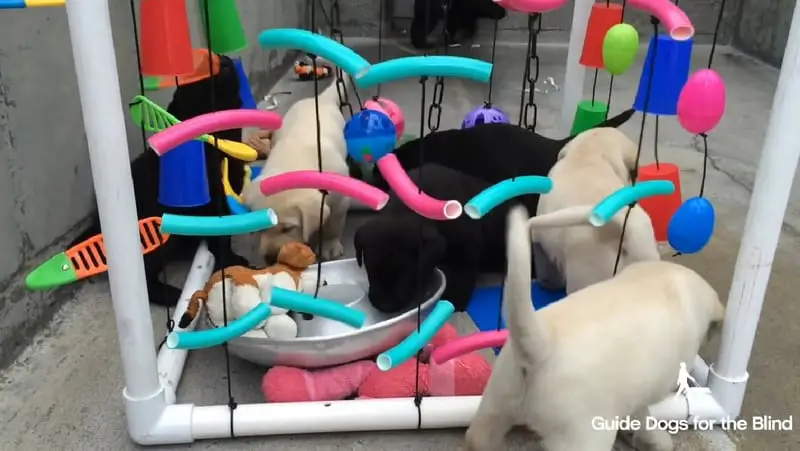
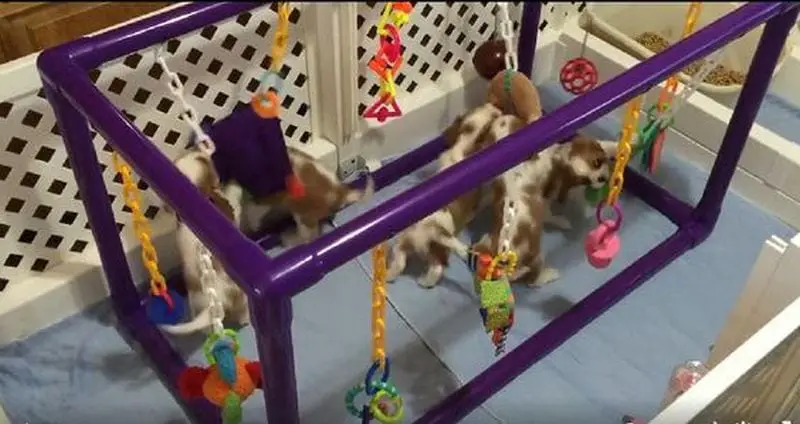
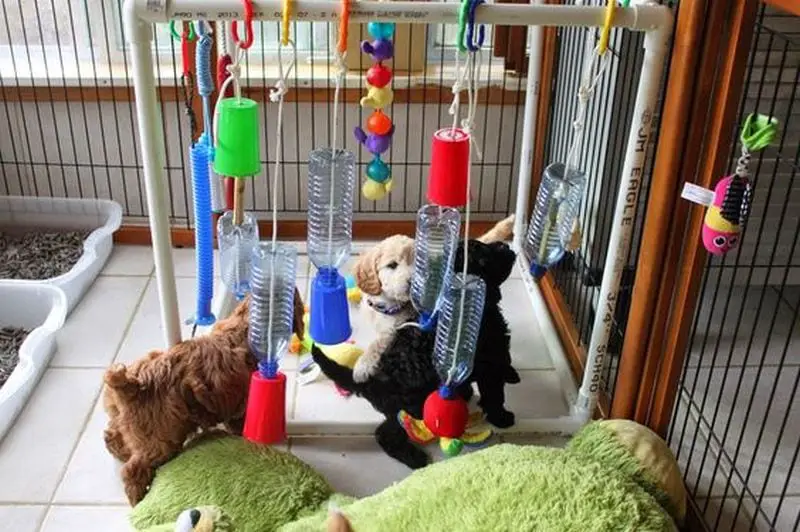
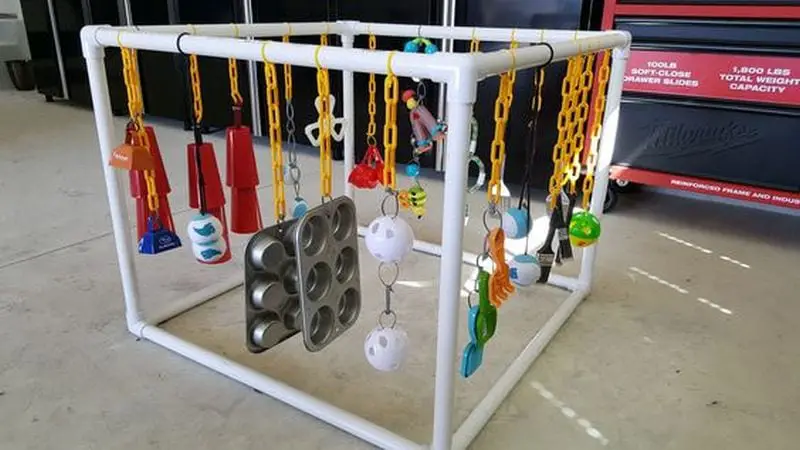
Creative Variations for Your Puppy Play Box
Customizing a puppy play box can add an extra layer of fun and engagement for your pet. Here are some creative variations to consider, ensuring your puppy’s playtime is both stimulating and enjoyable.
Themed Play Boxes
Creating a themed play box offers a unique and engaging experience for your puppy. For instance, a beach theme can transform the play area into a seaside adventure. Use shades of blue and beige to mimic water and sand.
Hang lightweight toys such as soft plush fish or miniature boats. During Halloween, you might add pumpkin-shaped toys or orange and black decor. For Christmas, think red and green ornaments or a mini Santa plush.
Remember, the key is to use safe, non-toxic, and durable materials that can withstand puppy play. These themes not only stimulate your puppy’s visual and tactile senses but also make the play box a dynamic and exciting part of your home decor.
Sensory Rich Experiences
Enhancing your puppy’s play box with a variety of textures and materials can significantly boost their sensory development. Incorporate soft, plush fabrics for them to nuzzle against, alongside crinkly materials that produce intriguing sounds.
Add toys with different surfaces – smooth, ridged, bumpy – to stimulate their sense of touch. You can even introduce items with varying degrees of hardness for a diverse chewing experience, which is especially beneficial for teething puppies.
The goal is to create a rich tapestry of sensory experiences that will keep your puppy’s curiosity piqued and support their exploratory learning process. This approach not only entertains your puppy but also aids in their cognitive and sensory development, making each play session both fun and educational.
Interactive Puzzle Elements
Incorporating puzzle toys or treat-dispensing toys in the puppy play box elevates the mental challenge for your puppy. Start with simple puzzles, like toys where treats are easily accessible. As your puppy gets better at solving these puzzles, introduce more complex ones.
Consider puzzles that require your puppy to move pieces with their nose or paws to find the treats. These activities not only keep them mentally stimulated but also develop their problem-solving skills. Regularly changing or upgrading the puzzles keeps the play box exciting and ensures that your puppy is continuously engaged and challenged as they grow and learn.
Nature-Inspired Elements
Adding nature-inspired elements to the puppy play box can create a more stimulating and natural environment for your puppy. Non-toxic plants, either real or artificial, can introduce your puppy to different smells and textures, simulating an outdoor experience.
Incorporating artificial grass or a small sandbox can also provide different textures for your puppy to explore, mimicking the feel of different terrains. These nature-inspired additions make the play box not just a play area but a learning environment, where your puppy can have a rich, multi-sensory experience that encourages natural exploratory behaviors.
Sound-Based Features
Incorporating sound-based features into the puppy play box can significantly enhance auditory stimulation for your pet. Items like bells, chimes, or toys with squeakers can create a range of sounds to captivate your puppy’s attention. You can also include toys that produce different volumes and pitches, such as soft rustling toys and louder rattles.
This variety helps in developing your puppy’s auditory skills, enabling them to differentiate and respond to a range of sounds. These auditory elements are not just entertaining but also play a crucial role in a puppy’s sensory development, preparing them for a world full of diverse sounds.
Adjustable Complexity
Designing a play box with adjustable complexity caters to the evolving learning curve of your puppy. Start with simpler challenges, such as toys that are easy to interact with or puzzles that require basic actions to solve. As your puppy grows and their skills improve, you can introduce more complex elements.
This could include multi-step puzzles, toys that require specific actions to activate, or sections of the box that change in texture or elevation. The ability to adjust the complexity keeps the play box continually engaging and relevant to your puppy’s developmental stage. This adaptability ensures that the play box remains a source of learning and enjoyment throughout different stages of your puppy’s growth.
Safety Tips for Your Puppy Play Box
Ensuring the safety of your puppy play box is crucial for a fun and harm-free playtime. Here are some essential safety tips to keep in mind when creating and maintaining your play box.
Regular Inspection
Ensuring the safety of your puppy’s play environment is paramount. Regular inspection of the puppy play box is essential to prevent accidents and injuries. Here are detailed steps to follow:
- Check for Loose Components
Examine the play box for any loose strings, cords, or attachments. Puppies are prone to chewing, and loose parts can be a choking hazard. If you find any, secure them immediately or remove them from the box.
- Inspect for Wear and Tear
Look for signs of wear and tear, such as frayed materials, cracked plastic, or worn-out toys. Puppies can be rough with their toys, and damaged items could lead to injuries. Replace any worn items with new, safe alternatives.
- Smooth Out Sharp Edges
Feel for any sharp edges or rough surfaces on the play box and its components. Over time, materials can break or splinter, creating sharp points. Sand down any rough areas to prevent cuts and scrapes.
- Tighten and Secure Joints
Ensure that all connections and joints in the play box structure are tight and secure. A loose frame can collapse or cause parts to fall off, posing a risk to your puppy. Tighten any loose fittings and reinforce the structure as needed.
- Cleanliness Check
Regularly clean the play box to maintain hygiene. Accumulated dirt, saliva, or food particles can breed bacteria, posing health risks. Use pet-safe cleaners to keep the play area sanitary and pleasant.
Appropriate Material Selection
Selecting the right materials for your puppy play box is critical for ensuring the safety and well-being of your pet. Here’s a more detailed guide on how to choose appropriate materials:
- Non-Toxic Materials
Prioritize materials that are non-toxic and pet-safe. This is especially important since puppies tend to chew on almost everything. Check for labels that confirm the material is safe for pets. Avoid materials that could release harmful chemicals or dyes when chewed or licked.
- Choking Hazard Prevention
Avoid incorporating small items that could pose choking hazards. Puppies are curious and might attempt to swallow small objects. Ensure that all components in the play box are large enough not to be swallowed but small enough for the puppy to interact with comfortably.
- Durability and Sturdiness
Choose materials that are durable and can withstand vigorous play. Puppies can be surprisingly strong and destructive. Materials should be sturdy enough to endure biting, pulling, and general rough play without breaking apart.
- Teeth and Gum Safety
Ensure that materials are gentle on your puppy’s teeth and gums. Avoid overly hard materials that could cause dental damage. Instead, opt for items that provide some resistance but are soft enough to be safe for a puppy’s developing mouth.
- Textural Variety
Include a variety of textures to stimulate your puppy’s sense of touch, but make sure all materials are safe for skin contact. Avoid anything that could irritate or injure their skin or gums.
Supervised Playtime
Always supervise your puppy during playtime. This helps you monitor how they interact with the play box and intervene if they start playing in a way that could be harmful. Supervision also allows you to see which elements they enjoy most, guiding future updates to the play box.
FAQ for DIY Puppy Play Box
What age should my puppy start using the play box?
How often should I change the items in the play box?
Can I use recycled materials to make a puppy play box?
How big should the puppy play box be?
How can I ensure the play box is safe for my puppy?
Can I leave my puppy alone with the play box?
Are there any specific materials I should avoid using in the play box?
How do I clean the puppy play box?
Can the play box be used for training purposes?
What if my puppy is afraid of the play box?
Conclusion
Creating a DIY puppy play box is a wonderful way to stimulate your puppy’s development in a fun and engaging manner. With the right materials, safety precautions, and a touch of creativity, you can provide your pet with an environment that promotes sensory exploration, physical activity, and cognitive growth.
If you enjoyed this, check our pallet dog bed where you can reuse materials into something your puppies will enjoy.





